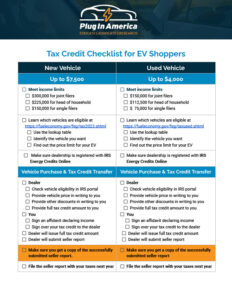The federal government recognizes the critical role an electrified transportation industry must play in combating climate change. Thanks to the Inflation Reduction Act, you can get up to $7,500 tax credit instantly when you buy or lease a new EV. Qualified used EVs may be eligible for up to $4,000 instantly.
What are you interested in?
EV Shopper Checklist
To simplify things for you, we created a checklist for EV shoppers who want to get the tax credit on new and used EVs at the time of the sale. Click on the image or button below to download the PDF.
2024 Federal Tax Credit Checklist for EV Shoppers
Things to Know About the Federal EV Tax Credits
- They can be stacked with other state and utility incentives. So, if you and the vehicle you want qualify for a federal tax credit, you can still take advantage of state and local EV incentives. They can really add up!
- Since January 1, 2024, the new EV tax credit and the used EV tax credit are available instantly at the time of sale. (Buyers must still file a tax return even if they don’t normally pay taxes and include the Vehicle Identification Number (VIN) on Form 8936)
- Each vehicle is eligible for one new EV tax credit and one used EV tax credit.
- The EV purchaser must be a taxpayer who is not a dependent of another taxpayer.
- The EV must be purchased for use and not be acquired for resale.
- The EV must have a Gross Vehicle Weight Rating (GVWR) of under 14,000 pounds (except for Commercial Clean Vehicles under IRC 45W).
- The vehicle must have a plug, meaning it must be propelled by an electric motor that draws power from a battery of at least 7kWh and be able to charge from an external source of electricity.
- The EV must be manufactured for use on public streets and have at least four wheels.
2024 EV Tax Credit Webinar
On Jan. 11, 2024, we hosted a webinar that covered:
- EV incentives at the local, state and federal levels
- Current credits for new, previously owned and commercial EVs
- Transferability and what’s new for 2024
- Buyer income limits and other qualifying requirements
- Important resources to stay informed
We also answered a good number of audience questions. Download the slides and watch the webinar below.
Federal Tax Credit FAQs
We’ve collected commonly asked questions that you access here.
Important: The guidance on this page is for vehicles delivered on or after January 1, 2024. For guidance on other time frames, visit our federal EV tax credit hub.
